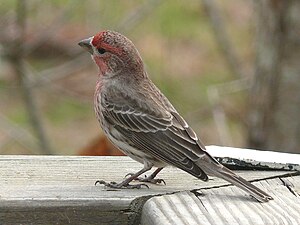 Image via Wikipedia
Image via WikipediaThe House Finch or Purple Finch immediately come to mind. If your trying to identify a bird that looks similar to a Pine Grosbeak you can go to http://www.allaboutbirds.org/ and type in the name. At the top and bottom of the page it usually has a place to click for the species that look similar.
In Michigan, if you have your feeders filled with WBU No-Mess Blend, sunflower, safflower or Nyjer® seed, the chances are good that one of the red finches of winter is probably a regular visitor to your yard.
The odds are best for a visit by the ubiquitous House Finch Carpodacus mexicanus. These 6″, talkative little birds get their name from their habit of hanging around houses. They build their nests in the hanging baskets, wreaths, or in trees, and their cheery warble or a variety of chirps is a constant around the bird feeders.
The amount of red the finch has can vary depending on the amount of carotenoid pigments consumed in its food during molt. They have slight white wing bands, a brownish red head with a pink chest that has brown streaking. They also appear to have a sleek body and stand tall.
Once restricted to the West, this talented songster became firmly established throughout all of eastern North America. In 1940, they were illegally captured in California and imported to New York by pet dealers. Fearing prosecution, the dealers released their “Hollywood Finches” on Long Island in 1940. Since then the finches have spread to all corners of the east and have even rejoined their relatives in the west.
House Finches are always exciting visitors to your feeders. These finches have a vegetarian diet like most finches. They do not rely on insects during the summer nesting season and continue to eat seeds all year-round.
Source: Wild Birds Unlimited BOTM
Category ›
Bird of the week
 Unknown
Unknown
 Saturday, January 22, 2011
Saturday, January 22, 2011











No comments:
Post a Comment